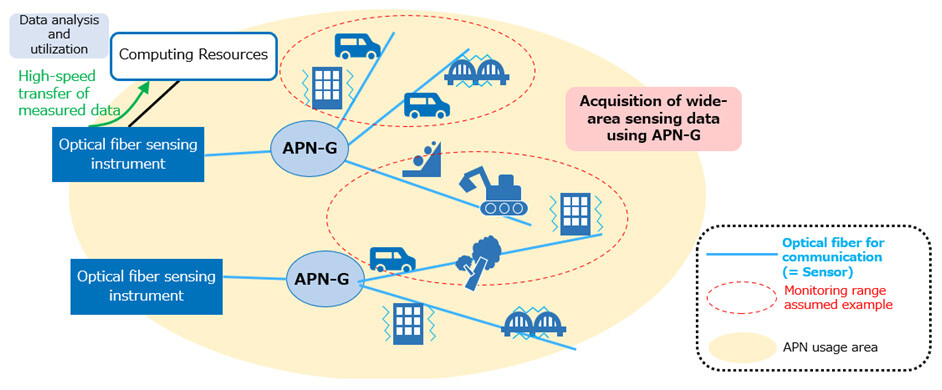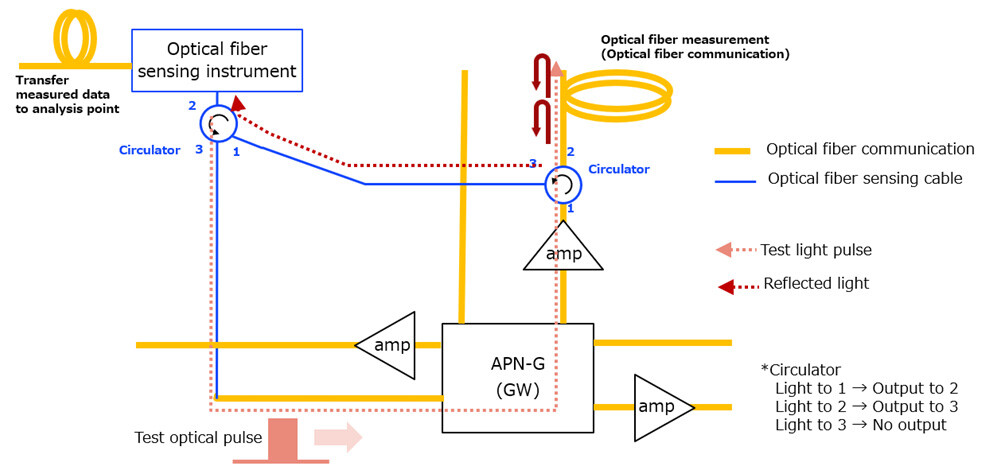Microsoft ends support for Internet Explorer on June 16, 2022.
We recommend using one of the browsers listed below.
- Microsoft Edge(Latest version)
- Mozilla Firefox(Latest version)
- Google Chrome(Latest version)
- Apple Safari(Latest version)
Please contact your browser provider for download and installation instructions.
September 30, 2024
NTT Corporation
NTT EAST Corporation
NTT WEST Corporation
NEC Corporation
IOWN All-Photonics Network with Optical Fiber Sensing Functions Achieves Wide-Area Traffic Flow Monitoring
Enabling flexible urban monitoring for APN dissemination
News Highlights:
- We devised and constructed a configuration that combines APN and optical fiber sensing, and verified that this configuration can realize wide-area traffic flow monitoring on open roads.
- In cooperation with the IOWN APN, we have established a technology that enables urban monitoring to be realized at a low cost, promptly, and flexibly.
TOKYO - September 30, 2024 - NTT Corporation (Headquarters: Chiyoda Ward, Tokyo; Representative Member of the Board and President: Akira Shimada; hereinafter "NTT"), NTT EAST Corporation (Headquarters: Shinjuku Ward, Tokyo; President: Naoki Shibutani; hereinafter "NTT EAST"), NTT WEST Corporation (Headquarters: Osaka City, Osaka Prefecture; President and CEO: Ryota Kitamura; hereinafter "NTT WEST") and NEC Corporation (Headquarters: Minato-ku, Tokyo; Member of the Board, President and CEO: Takayuki Morita; hereinafter "NEC") have jointly devised a connection configuration to add optical fiber sensing functions to the IOWN All-Photonics Network (APN)1. By applying this configuration to multiple routes of optical fiber for communication already laid underground (in the service area of NTT WEST in Osaka City), we have demonstrated that it is possible to grasp area-wide traffic trends using optical fiber sensing, and to visualize and analyze traffic conditions in real time.
Optical fiber sensing in the IOWN APN enables low-cost, prompt, and flexible expansion of urban monitoring across a wide plane. In the future, we will promote R&D and co-creation activities toward the establishment of more advanced optical fiber sensing that will contribute to solving social and regional issues by implementing optical fiber sensing in society and exploring usage scenarios based on these results.
1. Background
Optical fiber sensing, which enables the use of optical fiber for communication as a sensor, is expected to create new social value as demonstration tests and introduction of technologies for detecting construction vibration [1], supporting road snow removal decisions [2], and improving the efficiency of communication facility maintenance and operation progress [3]. The combination of IOWN and optical fiber sensing enables advanced data analysis by taking advantage of the high-speed transfer of large amounts of data by APN, and is thought to promote the use of sensing data. Furthermore, by using the optical path selection function of the APN-Gateway (APN-G)2, which composes APN, a single optical fiber sensing device can measure multiple existing communication optical fibers connected to APN-G. Thus, optical fiber sensing in conjunction with the IOWN APN has the potential to realize low-cost, prompt and flexible urban monitoring across a wide plane (Figure 1), and these advantages are described in the IOWN Global Forum publication [4].
With the aim of social implementation of optical fiber sensing using IOWNs, the four companies constructed a connection configuration that enables optical fiber sensing via APN-G, and conducted wide-area traffic flow monitoring on open roads. Several examples of traffic flow monitoring using optical fiber sensing have been reported [5], but this is the first case of wide area monitoring along multiple open roads.
 Figure 1 Wide-Area Optical Fiber Sensing Using IOWN
Figure 1 Wide-Area Optical Fiber Sensing Using IOWN
2. Point of the technology
- Construction of a connection configuration that can add optical fiber sensing functions to the APN-G
Since optical fiber sensing is measured using the round trip propagation of light, it is necessary to connect the optical fiber sensing instrument in a configuration that avoids devices (such as optical amplifiers) placed on the optical path of the APN that transmit light only in one direction. For this reason, we have devised and constructed a connection configuration between the APN-G and an optical fiber sensing device that uses a directional-coupler (optical circulator) to avoid a device (optical amplifier) that transmits light only in one direction of the APN-G and to extract the round trip sensing light (Figure 2). - Utilizing optical fiber for communication installed in underground pipelines
Since the measurement is possible without any modification to the communication optical fiber cable or underground conduit, it is possible to obtain sensing data from a wide area by effectively utilizing existing facilities. - Optimized vehicle speed analysis for open roads
Unlike long straight roads such as expressways, we conducted an analysis so that the speed and number of vehicles can be detected on short straight roads such as open roads with many intersections.
 Figure 2 Connection Configuration for Implementing Optical Fiber Sensing via IOWN APN
Figure 2 Connection Configuration for Implementing Optical Fiber Sensing via IOWN APN
3. Results of the joint experiment
Five vibration sensing devices were connected to the APN-G to simultaneously measure surface vibration on five routes (Wiring totaling 37 km, covering 8 km in four directions) of existing optical fiber communication cables (laid underground on roads in Osaka City). By analyzing this traffic vibration with a vehicle speed analysis algorithm, we were able to visualize in real time the average vehicle speed of vehicles on open roads, the amount of traffic on the road and its changes over time in a 200 m mesh granularity (Figure 3). In addition, it was confirmed that the results of the analysis of vehicle speed and number of vehicles tended to agree with the correct data measured at five sites. (Demonstration period: December 2023 to January 2024: Data measurement; February to July 2024: Analysis and verification of usefulness).
 Figure 3 Wide-Area Monitoring Results of Traffic Flow
Figure 3 Wide-Area Monitoring Results of Traffic Flow
Traffic flow meters on ordinary roads are installed at intervals of several kilometers only on major lines, requiring the permanent installation and operation of a huge number of sensors. However, optical fiber sensing linked to APN-G can flexibly monitor arbitrary points on optical fiber routes that extend to every corner of a city. It is expected to be used as a new social infrastructure, such as traffic congestion detection and prediction using traffic information collected from a wide area and application to urban traffic planning.
The connection configuration of the optical fiber sensing device to the APN-G used in this study was adopted in the IOWN Global Forum publication [6].
4. Role of each company
NTT: Devising and constructing a connection configuration to provide sensing functions to IOWN APNs
NTT EAST: Calibration of vehicle speed and vehicle count position
NTT WEST: Selection of traffic vibration monitoring sites and selection and provision of facilities for demonstration tests
NEC: Provision of APN-G and implementation of optical fiber vibration measurement and vehicle speed analysis
5. Outlook
Based on these achievements, we will continue developing the optical fiber sensing market using APNs collaborating with other companies, including discussions at the IOWN Global Forum. In addition, along with the nationwide expansion of APN, we aim to realize low-cost, wide-area urban monitoring that enables flexible sensing at arbitrary locations as long as it is connected with optical fiber, and does not require the installation and construction of permanent outdoor devices. In the future, we will promote R&D and co-creation activities aiming to solve social and regional issues through the social implementation of optical fiber sensing, with a perspective of various applications through urban monitoring, such as infrastructure monitoring, disaster prevention, and the realization of infrastructure design incorporating nature in urban planning.
[Glossary]
1IOWN APN (All-Photonics Network)
IOWN consists of three components: the All-Photonics Network (APN),which introduces photonics (optics) based technology to every aspect from the network to terminals; Digital Twin Computing, which enables advanced real-time interaction between objects and people in cyberspace; and the Cognitive Foundation, which efficiently deploys various ICT resources including these.
By introducing new optical technologies into the network, terminals, and chips, APN achieves ultra-low power consumption and ultra-high speed processing, which were previously difficult to achieve. By allocating wavelengths for each function on a single optical fiber, it is possible to provide multiple functions that support social infrastructure, such as information communication functions such as the Internet and sensing functions, without interfering with each other.
https://www.rd.ntt/e/iown/
2APN-G (APN-Gateway)
APN-G is one of the devices that make up APN and has functions such as wavelength assignment control, line concentration, and optical path selection.
[Reference]
{1}NTT EAST News Release, "NEC, Kashima, and NTT EAST succeeded in detecting construction vibration using the world's first optical fiber for communication," August 2023
https://www.ntt-east.co.jp/release/detail/20230824_01.html
{2}NTT News Release, "World's first vibration sensing technology using telecommunication optical networks for making road snow removal decisions in heavy snowfall areas," November 2023
https://group.ntt/en/newsrelease/2023/11/09/pdf/231109aa.pdf
{3}NTT EAST News Release, "Start of the operation of communication facility maintenance using optical sensing technology toward the IOWN era," May 2022
https://www.ntt-east.co.jp/release/detail/20220516_01.html
{4}IOWN Global Forum Functional Architectures "Fiber Sensing for Open APN 1.0"
https://iowngf.org/wp-content/uploads/2023/04/IOWN-GF-RD-FS_for_Open_APN-1.0.pdf
{5}NEC News Release, "NEC provides AI-based traffic monitoring system with fiber-optic sensing technology for NEXCO CENTRAL," May 2022
https://www.nec.com/en/press/202205/global_20220524_01.html
{6}IOWN Global Forum Functional Architectures "Fiber Sensing for Open APN 2.0"
https://iowngf.org/wp-content/uploads/2023/06/IOWN-GF-RD-Fiber_Sensing_for_Open_APN-2.0.pdf
About NTT
NTT contributes to a sustainable society through the power of innovation. We are a leading global technology company providing services to consumers and businesses as a mobile operator, infrastructure, networks, applications, and consulting provider. Our offerings include digital business consulting, managed application services, workplace and cloud solutions, data center and edge computing, all supported by our deep global industry expertise. We are over $97B in revenue and 330,000 employees, with $3.6B in annual R&D investments. Our operations span across 80+ countries and regions, allowing us to serve clients in over 190 of them. We serve over 75% of Fortune Global 100 companies, thousands of other enterprise and government clients and millions of consumers.
Media contacts
NTT Information Network Laboratory Group
Public Relations
nttrd-pr@ml.ntt.com
NTT EAST
Public Relations
houdou-gm@east.ntt.co.jp
NTT WEST
Public Relations
nttw-press@west.ntt.co.jp
NEC
Corporate Communications Dept.
press@news.jp.nec.com
Information is current as of the date of issue of the individual press release.
Please be advised that information may be outdated after that point.
NTT STORY
WEB media that thinks about the future with NTT










